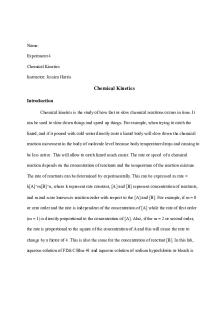Lab report A bagged Chemical Reaction PDF

| Title | Lab report A bagged Chemical Reaction |
|---|---|
| Author | Rontrell Jenkins |
| Course | Grade 12 Biology |
| Institution | Jose Marti MAST 6-12 Academy |
| Pages | 3 |
| File Size | 57.6 KB |
| File Type | |
| Total Downloads | 12 |
| Total Views | 152 |
Summary
Lab report chemistry helps with knowledge of chemistry within the min soul and spirit. learning is fundamental and quite resourceful...
Description
A Bagged Chemical Reaction Purpose - Observe the changes associated with a chemical reaction including heat changes, changes in an indicator, bubble of gas released. Determine which compounds are reactants and which are products, through the use of a chemical equation. Use indicators in order to identify whether a solution is acidic or basic.
Introduction - Chemical reactions occur when molecules come together to form new products. In our bodies and environments, chemical reactions occur continuously to help run our lives. Chemical reactions can be identified by a chemical equation in which reactants and products are characterized by chemical symbols. All chemical reactions are accompanied by a change in energy. Some reactions release energy to their surroundings and are called exothermic. Some reactions absorb heat from their surroundings which is called endothermic.
Procedures 1.
2.
3.
4. 5.
In a Ziploc bag, place 2 tablespoons of sodium bicarbonate and a film-canister (30 ml) with 3 drops of the phenol red indicator added to the water. Place canister in the bag in the upright position. Squeeze the excess air and seal the bag. Spill the water into the bag and record observations in Data Table 1. In another Ziploc bag add 1 tablespoon of calcium chloride and add the same amount of water as in the previous step but without the phenol red indicator. Repeat procedure in step 1. Record observations in Table 1 In another Ziploc bag, add 2 tablespoons of calcium chloride into one corner of the bag twist off the corner to separate chemical from the rest of the bag and tie. Into the opposing corner of the bag, add 2 tablespoons of sodium bicarbonate and twist off the corner to separate from the rest of the bag and tie. Squeeze the excess air and seal the bag.
A Bagged Chemical Reaction 6.
Carefully untwist the 2 corners (if using rubber bands, use scissors to cut them careful not to cut the bag) while the partner holds both corners apart 7. Release both corners and allow all three chemicals to mix. Quickly observe any immediate changes in the corners. Record all your observations in Table 1 8. In a fourth bag repeat steps #3-8 but this time with 3 drops of the phenol red indicator to the water. Record all your observations in Table
Data Table Physical or Production Chemical of gas Change
Color Change
Temperatu re Change
NaHCO3 in water + Indicator
Chemical
Carbon Dioxide
It turned blue
Endothermic Turned Cold
CaCl2 in water
Chemical
Carbon Dioxide
Clear
Exothermic Turned Warm
NaHCO3 + CaCl2 in water
Chemical
Carbon Dioxide
White
Endothermic Remained Cold
NaHCO3 + CaCl2 with water + Indicator solution
Chemical
Carbon Dioxide
Green
Endothermic Cold
Observation 1. Steps 1,2,3,4, and 8. This is because they all include a characteristic of utilizing chemicals. 2. The change in color or bubbles forming. 3. Process 2 is exothermic because it released heat into its surroundings. 4. Process 1,3,4 is endothermic because they absorbed heat from its surroundings.
A Bagged Chemical Reaction Conclusion’ 1. To indicate whether each chemical solution was acidic or basic. 2. 2NaHCO3+CaCl2 2NaCl+Ca(HCO3)2 3. Sodium Bicarbonate. Calcium Chloride, Sodium Chloride, Calcium Bicarbonate 4. Carbon Dioxide. By evaluating the chemical equation with a double replacement reaction. 5. The energy change could be originated in the air as a gas. 6. The law of conservation of energy...
Similar Free PDFs

Grignard Reaction Lab Report
- 11 Pages

Lab Report Reaction Rate Lab
- 3 Pages

Chemical Kinetic Lab Report
- 2 Pages

Lab Report Chemical Composition
- 3 Pages

Chemical Kinetics - lab report
- 4 Pages

Rates of chemical reaction
- 5 Pages

Green wittig reaction lab report
- 5 Pages

Iodine Clock Reaction Lab Report
- 4 Pages

Lab 11 Chemical Kinetics Report
- 4 Pages
Popular Institutions
- Tinajero National High School - Annex
- Politeknik Caltex Riau
- Yokohama City University
- SGT University
- University of Al-Qadisiyah
- Divine Word College of Vigan
- Techniek College Rotterdam
- Universidade de Santiago
- Universiti Teknologi MARA Cawangan Johor Kampus Pasir Gudang
- Poltekkes Kemenkes Yogyakarta
- Baguio City National High School
- Colegio san marcos
- preparatoria uno
- Centro de Bachillerato Tecnológico Industrial y de Servicios No. 107
- Dalian Maritime University
- Quang Trung Secondary School
- Colegio Tecnológico en Informática
- Corporación Regional de Educación Superior
- Grupo CEDVA
- Dar Al Uloom University
- Centro de Estudios Preuniversitarios de la Universidad Nacional de Ingeniería
- 上智大学
- Aakash International School, Nuna Majara
- San Felipe Neri Catholic School
- Kang Chiao International School - New Taipei City
- Misamis Occidental National High School
- Institución Educativa Escuela Normal Juan Ladrilleros
- Kolehiyo ng Pantukan
- Batanes State College
- Instituto Continental
- Sekolah Menengah Kejuruan Kesehatan Kaltara (Tarakan)
- Colegio de La Inmaculada Concepcion - Cebu






